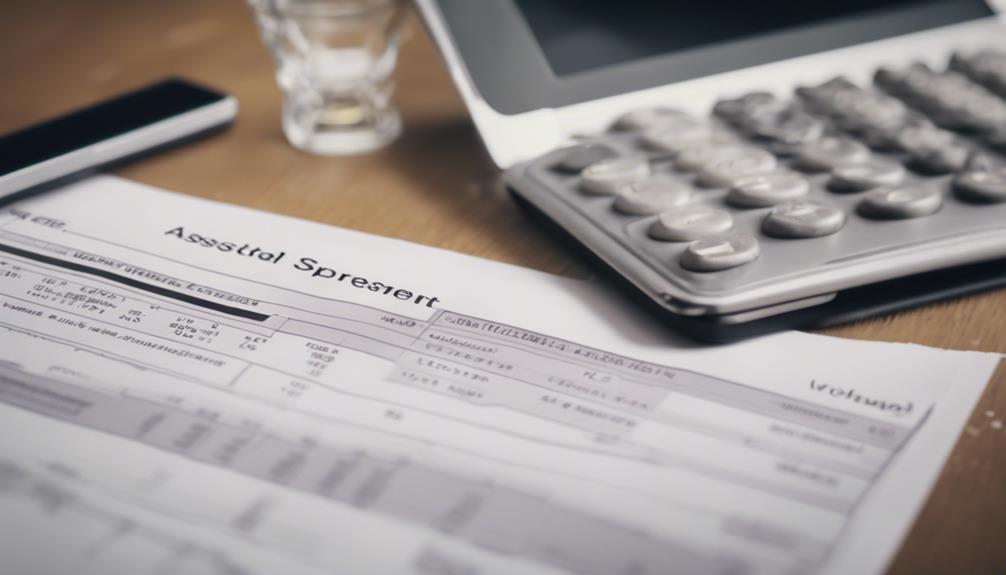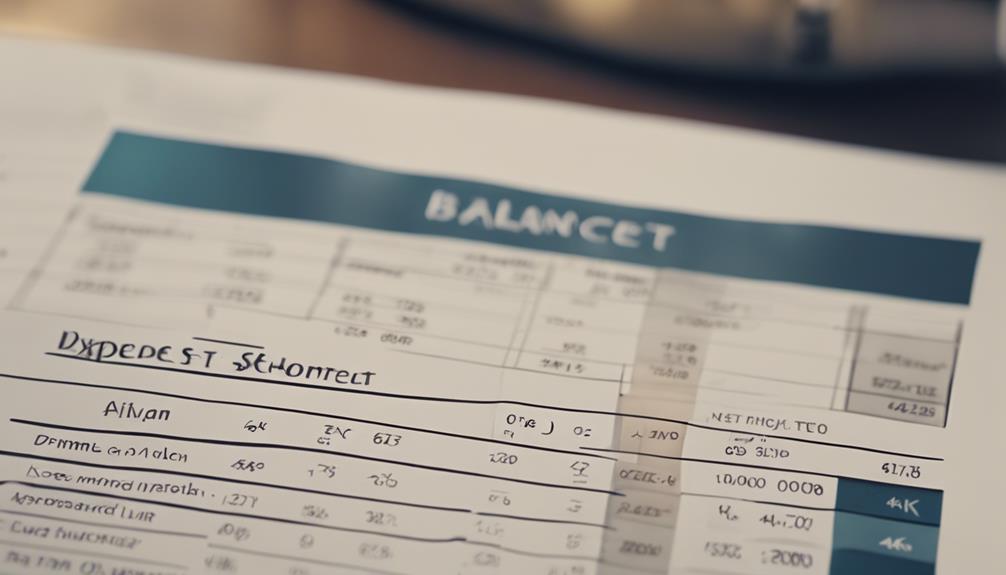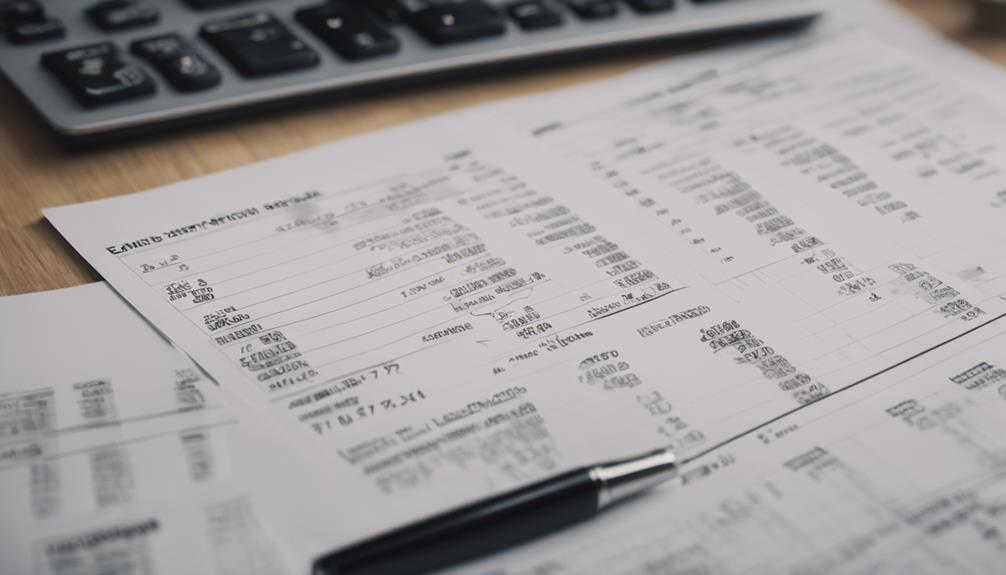Revealing the role of accumulated depreciation highlights its importance in financial accounting. It signifies total depreciation expenses, assisting in calculating net book value and adhering to the matching principle. This system spreads the cost of assets over their useful life, portraying a realistic value for long-term assets. It affects financial statements by decreasing fixed asset values, impacting the company's financial position, and determining depreciation expenses. Understanding its implications for asset management and depreciation expenses is crucial for informed financial decisions. Its evaluation methods guarantee an accurate representation of current asset worth, offering insights into financial strategies and future capital expenditures.
Key Takeaways
- Accumulated depreciation aids in determining net book value accurately.
- It influences financial decisions by reflecting realistic asset values.
- Helps in evaluating remaining useful life of assets for future planning.
- Crucial for true and fair financial reporting and tax deductions.
- Significantly impacts financial analysis, revealing true company asset worth.
Importance of Accumulated Depreciation

Accumulated depreciation plays a crucial role in accurately reflecting the depreciation costs incurred on long-term tangible assets. It represents the total depreciation expense recorded for an asset since its acquisition, aiding in determining the net book value of assets.
By accumulating depreciation over time, companies can spread out the cost of an asset across its useful life, aligning with the matching principle in accounting. This systematic allocation of depreciation expenses helps in presenting a more realistic value for long-term assets on the balance sheet.
Without proper consideration of accumulated depreciation, financial statements may not truly reflect the wear and tear experienced by these assets, potentially leading to misleading financial information for stakeholders.
Impact on Financial Statements

When considering the financial impact of accumulated depreciation, it becomes evident that accurate representation of asset values hinges on its meticulous calculation and reflection in financial statements. Accumulated depreciation directly affects the balance sheet by reducing the value of fixed assets. This reduction in asset value impacts the company's overall financial position and influences metrics like total assets and net worth.
On the income statement, accumulated depreciation plays an important role in determining depreciation expenses, which ultimately affect the company's profitability. Properly accounting for accumulated depreciation guarantees that financial statements provide a true and fair view of the company's financial health.
Hence, understanding and correctly reflecting accumulated depreciation are essential for transparent and accurate financial reporting.
Evaluating Asset Value

To accurately assess asset value, companies must employ robust evaluation methods that consider accumulated depreciation. Evaluating asset value involves understanding the impact of accumulated depreciation on the overall worth of the assets.
By factoring in the accumulated depreciation, businesses can determine the true value of their assets on the balance sheet. This evaluation is essential for making informed financial decisions, as it provides a more accurate representation of the assets' current worth.
Implications for Asset Management

Exploring the implications of accumulated depreciation on asset management reveals key insights into optimizing financial strategies.
Accumulated depreciation plays an essential role in determining the true value of assets on a company's balance sheet. By accurately reflecting the depreciation of long-term tangible assets, it provides a more realistic assessment of the company's financial health.
Effective asset management involves understanding how accumulated depreciation impacts the net book value of assets and influences financial decisions. Monitoring accumulated depreciation helps in evaluating the remaining useful life of assets, determining when replacements or upgrades are necessary, and planning for future capital expenditures.
Role in Depreciation Expense

Accumulated depreciation's impact on asset management highlights the importance of its role in determining depreciation expenses.
- Direct Influence: Accumulated depreciation directly impacts the amount of depreciation expense recognized on the income statement.
- Cost Allocation: It aids in spreading the cost of an asset over its useful life, aligning with the matching principle in accounting.
- Book Value Adjustment: By reducing the book value of assets, accumulated depreciation reflects a more accurate representation of an asset's worth.
- Financial Reporting: Proper calculation of depreciation expenses through accumulated depreciation is crucial for presenting a true and fair view of an entity's financial position.
Significance in Financial Analysis

Highlighting its crucial role, accumulated depreciation greatly influences financial analysis by offering insights into the true value of a company's assets. This figure plays a significant part in determining the net worth of a business by reflecting the total depreciation charged on its assets since acquisition.
Financial analysts rely on accumulated depreciation to assess the remaining value of long-term assets after factoring in depreciation expenses. It aids in evaluating the health of a company's balance sheet, providing a clearer picture of asset values.
Practical Applications in Accounting

Practitioners commonly utilize accumulated depreciation in various accounting applications to accurately reflect asset values and depreciation expenses.
- Financial Reporting: Accumulated depreciation plays an essential role in preparing financial statements by offsetting the costs of assets against their accumulated depreciation, providing a true representation of their value.
- Tax Purposes: Companies use accumulated depreciation to calculate tax deductions related to asset depreciation, impacting taxable income and overall tax liabilities.
- Asset Valuation: Understanding accumulated depreciation aids in determining the actual worth of assets on the balance sheet, helping stakeholders assess the company's financial health accurately.
- Decision-Making: Accurate tracking of accumulated depreciation assists in making informed decisions regarding asset maintenance, repairs, or replacements based on their remaining value.
Frequently Asked Questions
What Are the Implications of Accumulated Depreciation on Taxation?
Accumulated depreciation impacts taxation by reducing the value of assets, potentially leading to lower taxable income. As assets depreciate over time, the depreciation expenses can be deducted from the company's taxable income, decreasing the tax liability.
Understanding how accumulated depreciation affects asset values is essential for accurately reporting financial information and maximizing tax benefits. Properly managing accumulated depreciation can result in tax savings for businesses.
How Does Accumulated Depreciation Impact Cash Flow Statements?
Accumulated depreciation impacts cash flow statements by influencing net income, which is a component of cash flow from operating activities.
As depreciation is a non-cash expense, it's added back to net income when calculating cash flow.
This adjustment guarantees that the cash flow statement accurately reflects the cash generated by the business operations, offering insights into the company's ability to generate cash and meet financial obligations.
Can Accumulated Depreciation Be Reversed or Adjusted?
Accumulated depreciation can't be reversed or adjusted in financial statements. Once recorded, it continues to accumulate over time as an asset's value decreases.
Adjusting accumulated depreciation could misrepresent the true value of assets and impact financial reporting accuracy. It serves as an essential element in reflecting the historical cost of assets and should be maintained accurately for proper financial evaluation.
How Does Accumulated Depreciation Affect Asset Disposal Decisions?
Accumulated depreciation impacts asset disposal decisions by reducing the asset's book value. As depreciation accumulates over time, the net value of the asset decreases, affecting its potential sale price or trade-in value.
Understanding the accumulated depreciation amount is essential for accurately evaluating the financial implications of disposing of an asset. It provides insights into the actual worth of the asset and guides decision-making regarding its disposal.
What Are the Regulatory Requirements for Reporting Accumulated Depreciation?
Regulatory requirements for reporting accumulated depreciation demand accurate financial disclosure. Companies must detail accumulated depreciation under fixed assets, showcasing the net value of long-term tangible assets. Placement varies based on asset complexity.
Not classified as a current asset, accumulated depreciation is essential for financial health assessments. Proper accounting treatment involves crediting the account and debiting the fixed asset, with balances increasing as assets depreciate.
Understanding methods like straight-line depreciation is important for precise financial reporting.
Conclusion
In summary, accumulated depreciation plays a crucial role in accurately evaluating the value of long-term tangible assets. By understanding its impact on financial statements and asset valuation, companies can make informed decisions about asset management and financial health.
The careful calculation and recording of accumulated depreciation are essential for maintaining precise records and ensuring the reliability of financial reporting. Embracing the role of accumulated depreciation is essential for navigating the complexities of asset depreciation in the world of accounting.










